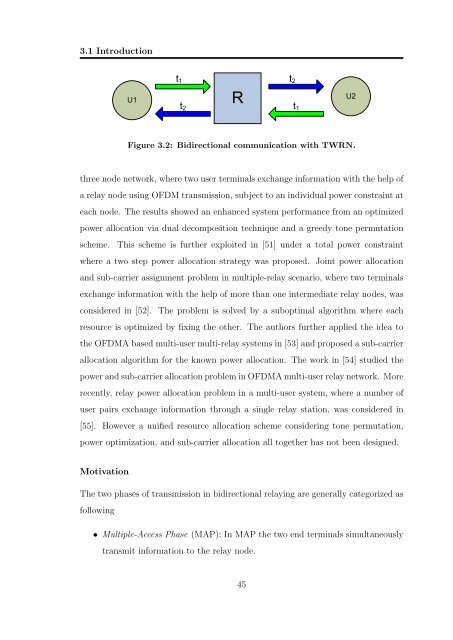Resource Allocation in OFDM Based Wireless Relay Networks ...
Resource Allocation in OFDM Based Wireless Relay Networks ...
Resource Allocation in OFDM Based Wireless Relay Networks ...
Create successful ePaper yourself
Turn your PDF publications into a flip-book with our unique Google optimized e-Paper software.
3.1 Introduction<br />
Figure 3.2: Bidirectional communication with TWRN.<br />
three node network, where two user term<strong>in</strong>als exchange <strong>in</strong>formation with the help of<br />
a relay node us<strong>in</strong>g <strong>OFDM</strong> transmission, subject to an <strong>in</strong>dividual power constra<strong>in</strong>t at<br />
each node. The results showed an enhanced system performance from an optimized<br />
power allocation via dual decomposition technique and a greedy tone permutation<br />
scheme. This scheme is further exploited <strong>in</strong> [51] under a total power constra<strong>in</strong>t<br />
where a two step power allocation strategy was proposed. Jo<strong>in</strong>t power allocation<br />
and sub-carrier assignment problem <strong>in</strong> multiple-relay scenario, where two term<strong>in</strong>als<br />
exchange <strong>in</strong>formation with the help of more than one <strong>in</strong>termediate relay nodes, was<br />
considered <strong>in</strong> [52]. The problem is solved by a suboptimal algorithm where each<br />
resource is optimized by fix<strong>in</strong>g the other. The authors further applied the idea to<br />
the <strong>OFDM</strong>A based multi-user multi-relay systems <strong>in</strong> [53] and proposed a sub-carrier<br />
allocation algorithm for the known power allocation. The work <strong>in</strong> [54] studied the<br />
power and sub-carrier allocation problem <strong>in</strong> <strong>OFDM</strong>A multi-user relay network. More<br />
recently, relay power allocation problem <strong>in</strong> a multi-user system, where a number of<br />
user pairs exchange <strong>in</strong>formation through a s<strong>in</strong>gle relay station, was considered <strong>in</strong><br />
[55]. However a unified resource allocation scheme consider<strong>in</strong>g tone permutation,<br />
power optimization, and sub-carrier allocation all together has not been designed.<br />
Motivation<br />
The two phases of transmission <strong>in</strong> bidirectional relay<strong>in</strong>g are generally categorized as<br />
follow<strong>in</strong>g<br />
• Multiple-Access Phase (MAP): In MAP the two end term<strong>in</strong>als simultaneously<br />
transmit <strong>in</strong>formation to the relay node.<br />
45

















